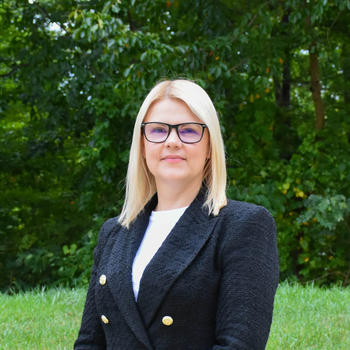The economic balance is shifting toward private equity. But accounting scholars are still working from an outdated playbook.
It’s a time of transformation for capital markets. And Maria Nykyforovych, assistant professor of accounting at George Mason University School of Business, believes that accounting research can help resolve the confusions of economic change. But scholars must update their thinking first.

As she explains, the balance is quickly shifting away from public equity markets and toward private funds, with private equity (PE) emerging as an especially significant asset class. In 2017, U.S. private markets for the first time surpassed the NASDAQ and Dow Jones in capital raised. Globally, PE has been the primary driver of this explosive growth, expanding fifteen-fold since the year 2000 (from $500 billion to $7.6 trillion assets under management).
Meanwhile, the number of publicly listed companies in the U.S. has dropped by more than half since the mid-1990s.
“One reason for the shift may be that when you’re a publicly listed company, you really have to watch your financial reporting. In private equity, that does not exist. You can raise huge sums of money, but you don’t have to report all that much,” Nykyforovych says.
This perceived lack of accountability and transparency, combined with PE’s sudden ubiquity across the economy, is a recipe for political controversy. Recently, the Securities and Exchange Commission announced sweeping new disclosure requirements on private funds, prompting a lawsuit from some of PE’s biggest players.
Nykyforovych is one of only a few accounting researchers working to help penetrate the fog of ideology and secrecy surrounding private equity. “For example, when PE enters health care, it can potentially make that hospital more efficient. But on the other hand, preliminary research seems to show that prices also go up significantly…At a recent conference on health care and private equity, the keynote speaker said ‘We would love for you to come in and do some analysis, because right now we don’t have enough data to make data-driven decisions, not just political decisions, about what these companies are telling us.’”
But the research methods and bedrock assumptions of accounting scholars—including editors and reviewers for the field’s top journals—are still largely geared toward publicly listed companies. As a result, the body of extant research on PE is quite limited.
That is why Nykyforovich—working with co-authors Paul Mason of Baylor University and Steven Utke of University of Connecticut—wrote the paper “Understanding Private Equity Funds: A Guide to Private Equity Research in Accounting,” recently published in Journal of Financial Reporting. It was intended to guide scholars through the institutional features that set PE apart from other asset classes, and the novel research opportunities that arise from those differences.
One of the most important points of divergence concerns the time horizon of PE investments. “In conventional research, there is an assumption that this business is going to operate forever. It will not go bankrupt; it’s going to continue to exist. That’s called ‘going concern’. But in PE, the fund always, always has a life. The expectation used to be ten years, nowadays it may be more like 12—but still, it’s limited. That’s a big shift in understanding how executives work, if you know that the fund that generates your compensation has an end date,” Nykyforovych says.
In research, of course, it always comes back to the data. Since PE funds are currently not subject to the same disclosure rules as publicly listed companies, accounting scholars are at a decided disadvantage. However, Nykyforovych’s paper covers several useful sources that have been made commercially available in recent years. For instance, The Burgiss Group, a software provider serving PE fund managers, offers aggregate-level performance data enabling researchers to compare funds across different dimensions (size, type, location, etc.) These resources often come with restrictions researchers should be aware of. “Burgiss requires that before I send my paper anywhere, their legal department reads it and can flag things they’re not comfortable with,” Nykyforovych says. “It never affects my impartiality or the basic results, but the words you use can be different. We might be asked to use ‘loss avoidance’ instead of ‘earnings management’, for example.”
So far, Nykyforovych has written four papers on private equity, including the above-mentioned guide to PE. Her ongoing research concerns questions of PE’s concrete contributions to ESG (environmental, social and governance) goals. “Are funds actually reducing investments in, say, fossil fuels and moving their capital toward green energy and some of these good things? Or are they just window dressing?”
As Nykyforovych sees it, accounting research can add to our understanding of the societal trade-offs presented by the PE boom. Vital considerations such as health care accessibility and environmental impact must be weighed against broad-based economic gains.
“State-run pension plans invest heavily in PE because they can offer excess returns that teachers and firefighters, etc. are getting once they retire,” Nykyforovych says. “There’s a lot of good that PE does. Research can help regulators formulate data-driven decisions and sensible policies.”
- December 4, 2025
- December 1, 2025
- November 7, 2025
- November 3, 2025
- October 24, 2025
